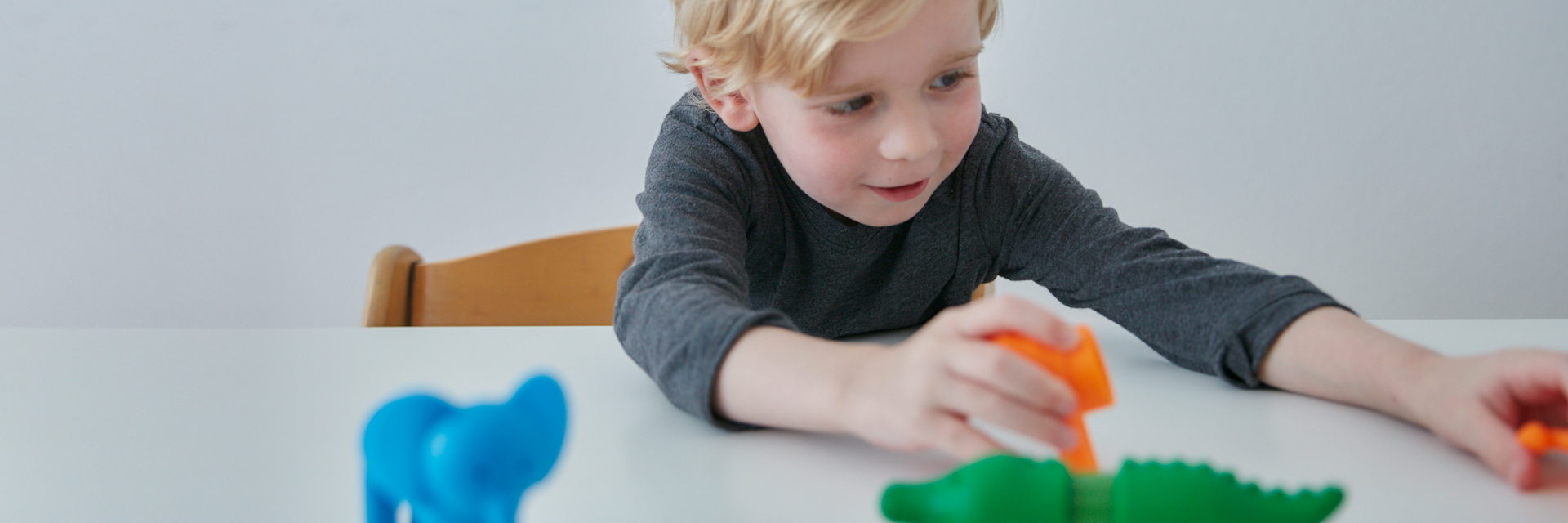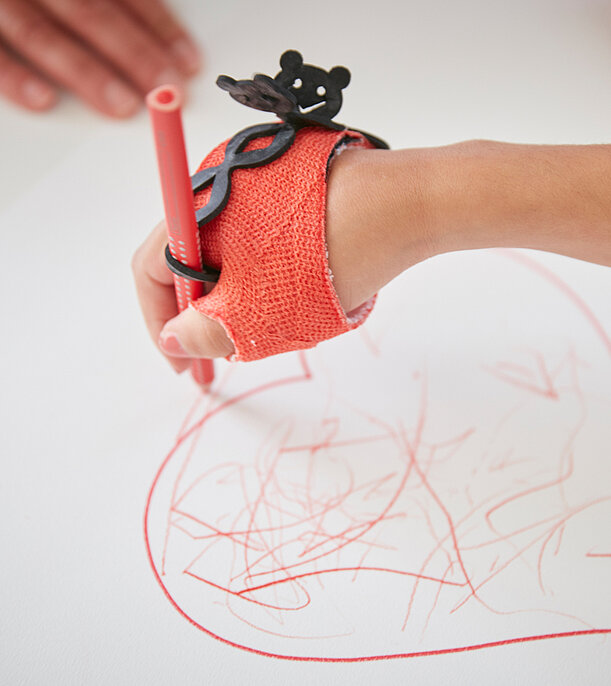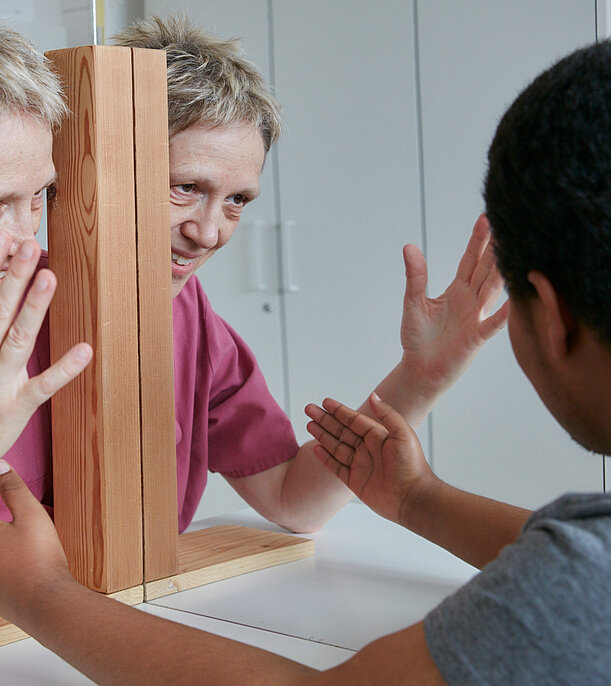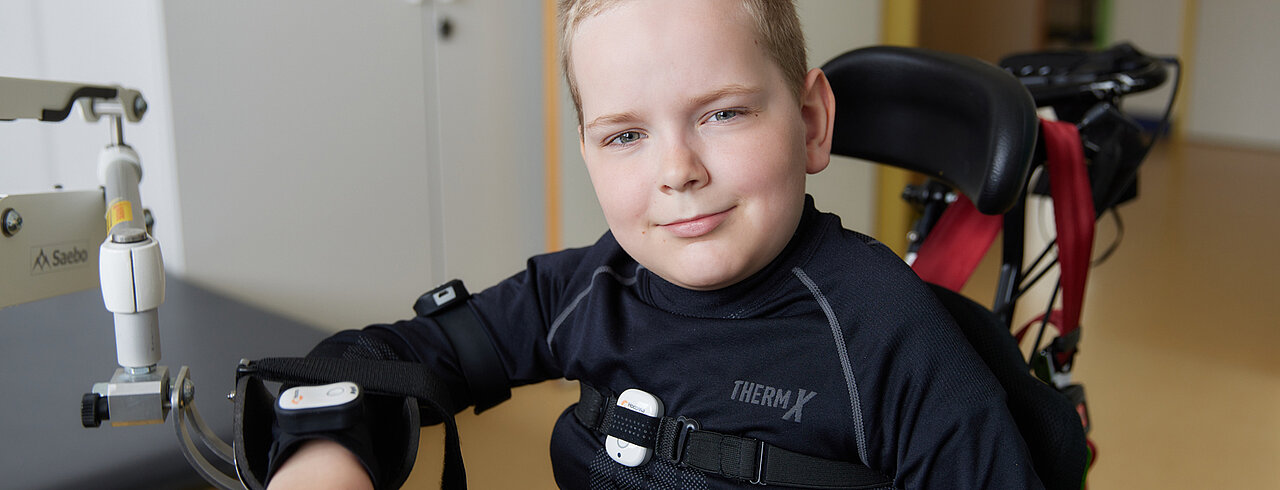
Occupational therapy
Targeted occupational therapy for the best possible independence
The work of occupational therapy aims to enable the persons concerned to carry out important everyday activities - in kindergarten, at school and at work or in their leisure time.
To this end, our occupational therapists work together with the patients and their relatives to develop, regain or maintain individual solutions to enable them to act in everyday life and thus participate in life.
The key to individual and goal-oriented therapy is occupational therapy diagnostics. The subsequent occupational therapy treatment can also include other special procedures, depending on the individual's needs:
Biofeedback - Device-assisted therapy - Animal-assisted therapy.

Occupational therapy diagnostics as an indispensable basis for goal-oriented therapy
Occupational therapy assessment serves to identify the abilities and problems of the person concerned, to understand interrelationships, and to derive treatment targets and treatment content from this.
Standardised tests, assessments and work samples are used to diagnose abilities and problems in the areas of motor skills, cognition and perception. In addition to the occupational therapy inventory of motor, sensory and cognitive resources, it is of utmost importance to record which problems exist in everyday life and to jointly search for solutions for them.
Observations in everyday and play situations enable us to recognise the individual competences and thus decide on which basis the therapy can be built.
We regularly try to provide more effective everyday aids by testing them. We work together with external providers of aids for special needs.
Also for ADHD, various tests and work trials help us to make decisions for individual medication and other therapeutic interventions.

Focused on therapy
Occupational therapy treatment at the Children's Hospital Schömberg covers a very wide range of therapy options. We treat mainly in individual therapy and always focus on the individual aims and possibilities of the patients and their relatives.
Occupational therapy treatment in the motor area can focus on improving movement sequences (body motor skills, fine motor skills) and coordination as well as tonus regulation. The treatment is carried out according to the principles of the Bobath concept.
Development and improvement of sensorimotor and cognitive abilities are achieved by training of coordination and integrating sensory perceptions. We also use special therapy methods to improve concentration, endurance, attention, memory and orientation.
We work on difficulties in performing and controlling actions in different areas of life. The development and improvement of socio-emotional skills, e.g. emotional control, affects, motivation or communication, are particularly important to us. Severe impairment of communicational skills we try to address by testing communication devices in cooperation with various companies for electronic aids and other departments of the clinic.
If necessary, everyday aids are adapted and tested. Therefore we also collaborate with experienced external service providers.

Orthoses are provided for various purposes: Positional orthoses are splints to maintain joint mobility or functional positions. Functional orthoses splint the arm or hand and additionally serve to improve movement sequences.
Positioning orthoses are fitted bedside by the occupational therapists using mainly thermoplastic material. They are therefore directly available when needed and serve to prevent contractures or to regulate tone.
In the case of special function-improving hand or elbow orthoses or splints made of other materials, we work together with orthopaedic technicians from medical supply stores. Elastic materials or spring joints enable movements such as grasping or releasing and thus expand hand and arm function.

We use these two therapy methods for acquired, unilateral movement disorders of the upper extremities.
Patients with unilateral cerebral palsy or other unilateral movement disorders suffer not only from functional limitations but also from an additional loss of dexterity and strength. This is caused by a lack of activity also known as “learned non-use”. The additional problems caused by this can be avoided by intensive exercises with the affected hand.
Mirror therapy can be started when hardly any active movements are possible, but with CIMT treatment these are already a prerequisite.
We select the appropriate therapy method in each case according to the findings.

Biofeedback - communicating with your own body
Biofeedback is a method in which one's own body signals are fed back through the use of a computer. In this way, it is possible to learn how to influence these bodily functions.
The aim of biofeedback treatment is the targeted perception and influencing of bodily processes. It supports the patient to recognize what influence these have on his/her own motor function, breathing or relaxation, and how these can be positively changed. For this purpose, the biosignals, for example muscle tension, breathing, skin conductance or blood flow, are recorded with the help of electrodes or sensors on the skin, sent to a computer and displayed there visually or acoustically with special software. The task is now to influence and modulate the visually or acoustically displayed results.

Device-based therapy enables targeted motor learning
Using appropriate equipment when motor skills are restricted or absent, targeted action or activity can be improved, re-evoked and sometimes even primarily initiated.
The areas of application of equipment in occupational therapy are manifold. Focal points in our work at the Children's Hospital Schömberg are:
Arm/hand training
This training is carried out with the ArmeoSenso from Hocoma and the Mindmotion Go from Mindmaze as well as the Smart Glove from Neofect. Due to their challenging character, the devices offer a variety of interesting possibilities to train and improve sensorimotor skills in order to achieve functional goals. They can also be used to document progress and success.
Strength, mobility and balance
The Motomed Arm Trainer can be used to train mobility, strength and endurance of the shoulder and arm. If weight relief is required to train weak or painful muscles, various help arms are used. Balance and coordination can be practised with the BalensoSenso.
Use of tablet or PC
When training with a tablet or PC with a touch screen, a touch can trigger an effect or a sensor or adapted mouse can enable learning or communication. Together with the patients and parents, we try out aids for PC or tablet operation to enable participation in everyday digital life.
Eye control
With the Gaze Viewer from Tobii, we enable PC control with the eyes and thus aided communication.
Electrical stimulation
Depending on the problem, muscle stimulation is used to relax or tone the muscles or to improve muscle sensation, perception and circulation. With the help of electrical stimuli, we trigger targeted muscle contractions. If these are coordinated in such a way that a function is supported, we speak of functional electrostimulation. Often the aim is to activate insufficiently supplied muscles and try to involve them better.

Animal-assisted therapy is successfully used for a variety of goals
Animal-assisted therapy is a targeted intervention for various indications. The contact with the animal serves to improve the physical and motor, social, emotional and/or cognitive abilities of a person and is offered in various settings, in the form of group or individual treatments.
The animal takes on a bridging function and motivates the person concerned to take on a certain action. This can be, for example, grooming or the preparation and presentation of food. For example, hands are deliberately opened to feed treats.
Walking distances can also be increased in an appealing way, and completing obstacle course tasks promotes the patients' coordination skills. The interaction with the animal becomes a concentration task.
The dog turns to the patient in a non-judgemental way and helps to stabilise the patient psychologically through closeness, which conveys trust and security. The kindergarten children are also happy when the dog comes to visit regularly.
Our therapy dog Fanny is a certified therapy companion dog (Canis Lupus Therapeuticus e.V.).



Contact
Tanja Mangelsdorf
Occupational therapist in charge of ward B
E-Mail: ergotherapie@kiklisch.de



